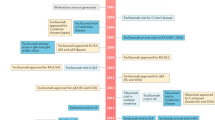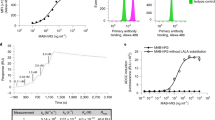Abstract
Interleukin (IL)-6 is a pleiotropic cytokine that has important roles in the regulation of the immune response, inflammation, and hematopoiesis. Disruption of IL-6 regulation might, however, affect the immune response and consequently induce immune-mediated inflammatory diseases such as rheumatoid arthritis, systemic juvenile idiopathic arthritis, Castleman disease, and Crohn's disease. Overproduction of IL-6 also contributes, through its roles as a growth factor or an antiapoptotic factor, to the development of malignant diseases such as multiple myeloma and renal cancer. Progress in the study of IL-6 has increased our understanding of the pathological roles of this cytokine in these diseases and provided key evidence that antagonizing its activities can be used as a therapeutic strategy. The application of molecular biology techniques to design monoclonal antibodies as therapeutic agents has made it possible to regulate the IL-6 signal to successfully treat diseases that have so far proved refractory to conventional therapies. Blocking IL-6 actions by use of a humanized antibody, tocilizumab, which targets the IL-6 receptor, has been proven to be therapeutically effective for rheumatoid arthritis, systemic juvenile idiopathic arthritis, Castleman disease and Crohn's disease. In this review, we discuss a paradigm of IL-6 from basic science to clinical use.
Key Points
-
IL-6 is a pleiotropic cytokine, which has important roles in the regulation of the immune response, inflammation, and hematopoiesis
-
Constitutive overproduction of IL-6, however, might cause immune-mediated inflammatory diseases, such as rheumatoid arthritis and systemic juvenile idiopathic arthritis
-
Successful treatment of these diseases with a humanized anti-IL-6 receptor antibody tocilizumab has proven the clinical benefit of IL-6 blockade, and has also confirmed the pathological roles of IL-6 in these diseases
This is a preview of subscription content, access via your institution
Access options
Subscribe to this journal
Receive 12 print issues and online access
$209.00 per year
only $17.42 per issue
Buy this article
- Purchase on Springer Link
- Instant access to full article PDF
Prices may be subject to local taxes which are calculated during checkout


Similar content being viewed by others
References
Yoshizaki K et al. (1984) Isolation and characterization of B cell differentiation factor (BCDF) secreted from a human B lymphoblastoid cell line. J Immunol 132: 2948–2954
Hirano T et al. (1986) Complementary DNA for a novel human interleukin (BSF-2) that induces B lymphocytes to produce immunoglobulin. Nature 324: 73–76
Wolvekamp MC and Marquet RL (1990) Interleukin-6: historical background, genetics and biological significance. Immunol Lett 24: 1–9
Kishimoto T (1989) The biology of interleukin-6. Blood 74: 1–10
Nemeth E et al. (2004) IL-6 mediates hypoferremia of inflammation by inducing the synthesis of the iron regulatory hormone hepcidin. J Clin Invest 113: 1271–1276
Weber J et al. (1993) Phase I trial of subcutaneous interleukin-6 in patients with advanced malignancies. J Clin Oncol 11: 499–506
Nakahara H et al. (2003) Anti-interleukin-6 receptor antibody therapy reduces vascular endothelial growth factor production in rheumatoid arthritis. Arthritis Rheum 48: 1521–1529
Tamura T et al. (1993) Soluble interleukin-6 receptor triggers osteoclast formation by interleukin-6. Proc Natl Acad Sci USA 90: 11924–11928
Kawano M et al. (1988) Autocrine generation and requirement of BSF-2/IL-6 for human multiple myelomas. Nature 332: 83–85
Miki S et al. (1989) Interleukin-6 (IL-6) functions as an in vitro autocrine growth factor in renal cell carcinomas. FEBS Lett 250: 607–610
Horii Y et al. (1989) Involvement of interleukin-6 in mesangial proliferation of glomerulonephritis. J Immunol 143: 3949–3955
Klein B et al. (1989) Paracrine rather than autocrine regulation of myeloma-cell growth and differentiation by interleukin-6. Blood 73: 517–526
Suematsu S et al. (1989) IgG1 plasmacytosis in interleukin-6 transgenic mice. Proc Natl Acad Sci USA 86: 7547–7551
Suematsu S et al. (1992) Generation of plasmacytomas with the chromosomal translocation t(12;15) in interleukin 6 transgenic mice. Proc Natl Acad Sci USA 89: 232–235
Olsen NJ and Stein CM (2004) New drugs for rheumatoid arthritis. N Engl J Med 350: 2167–2179
Keane J et al. (2001) Tuberculosis associated with infliximab, a tumor necrosis factor alpha-neutralizing agent. N Engl J Med 345: 1098–1104
Sack U et al. (1993) Interleukin-6 in synovial fluid is closely associated with chronic synovitis in rheumatoid arthritis. Rheumatol Int 13: 45–51
Madhok R et al. (1993) Serum interleukin 6 levels in rheumatoid arthritis: correlation with clinical and laboratory indices of disease activity. Ann Rheum Dis 52: 232–234
Pawlik A et al. (2005) IL-6 promoter polymorphism in patients with rheumatoid arthritis. Scand J Rheumatol 34: 109–113
Atsumi T et al. (2002) A point mutation of Tyr-759 in interleukin 6 family cytokine receptor subunit gp130 causes autoimmune arthritis. J Exp Med 196: 979–990
Alonzi T et al. (1998) Interleukin-6 is required for the development of collagen-induced arthritis. J Exp Med 187: 461–468
Sasai M et al. (1999) Delayed onset and reduced severity of collagen-induced arthritis in interleukin-6-deficient mice. Arthritis Rheum 42: 1635–1643
Hata H et al. (2004) Distinct contribution of IL-6, TNF-alpha, IL-1, and IL-10 to T cell-mediated spontaneous autoimmune arthritis in mice. J Clin Invest 114: 582–588
Takagi N et al. (1998) Blockage of Interleukin-6 receptor ameliorates joint disease in murine collagen-induced arthritis. Arthritis Rheum 41: 2117–2121
Mihara M et al. (2001) Humanized antibody to human interleukin-6 receptor inhibits the development of collagen arthritis in cynomolgus monkeys. Clin Immunol 98: 319–326
Montero-Julian FA et al. (1995) Pharmacokinetic study of anti-interleukin-6 (IL-6) therapy with monoclonal antibodies: enhancement of IL-6 clearance by cocktails of anti-IL-6 antibodies. Blood 85: 917–924
Sato K et al. (1993) Reshaping a human antibody to inhibit the interleukin-6-dependent tumor cell growth. Cancer Res 53: 851–856
Nishimoto N et al. (2003) Toxicity, pharmacokinetics, and dose finding study of repetitive treatment with humanized anti-interleukin 6 receptor antibody, MRA, in rheumatoid arthritis. Phase I/II clinical study. J Rheumatol 30: 1426–1435
Choy EH et al. (2002) Therapeutic benefit after blocking interleukin-6 activity in rheumatoid arthritis with an anti-interleukin-6 receptor monoclonal antibody. Arthritis Rheum 46: 3143–3150
Nishimoto N et al. (2004) Treatment of rheumatoid arthritis with humanized anti-interleukin-6 receptor antibody: a multicenter, double-blind, placebo-controlled trial. Arthritis Rheum 50: 1761–1769
Maini RN et al. (2003) Efficacy of IL-6 receptor antagonist MRA in rheumatoid arthritis patients with an incomplete response to methotrexate (CHARISMA) [abstract #1704]. Arthritis Rheum 48 (Suppl): S652
Felson DT et al. (1995) American College of Rheumatology. Preliminary definition of improvement in rheumatoid arthritis. Arthritis Rheum 38: 727–735
Gillmor JD et al. (2001) Amyloid load and clinical outcome in AA amyloidosis in relation to circulating concentration of serum amyloid A protein. Lancet 358: 24–29
Sasaki A et al. (2000) CIS3/SOCS-3 suppresses erythropoietin (EPO) signaling by binding the EPO receptor and JAK2. J Biol Chem 275: 29338–29347
Nishimoto N et al. (2005) Blocking interleukin-6 (IL-6) by tocilizumab (a humanized anti-interleukin-6 receptor monoclonal antibody) monotherapy reduces joint damage in active rheumatoid arthritis (RA): evidence from a X-ray reader-blinded randomised controlled trial [abstract #L27]. Arthritis Rheum 52 (Suppl)
Petty RE et al. (2004) International League of Associations for Rheumatology. International League of Associations for Rheumatology classification of juvenile idiopathic arthritis: second revision, Edmonton, 2001. J Rheumatol 31: 390–392
Martini A et al. (1994) Intravenous iron therapy for severe anaemia in systemic-onset juvenile chronic arthritis. Lancet 344: 1052–1054
Cazzola M et al. (1996) Defective iron supply for erythropoiesis and adequate endogenous erythropoietin production in the anemia associated with systemic-onset juvenile chronic arthritis. Blood 87: 4824–4830
Quartier P et al. (2003) Efficacy of etanercept for the treatment of juvenile idiopathic arthritis according to the onset type. Arthritis Rheum 48: 1093–1101
Ramanan AV and Schneider R (2003) Macrophage activation syndrome following initiation of etanercept in a child with systemic onset juvenile rheumatoid arthritis. J Rheumatol 30: 401–403
de Benedetti F and Martini A (1998) Is systemic juvenile rheumatoid arthritis an interleukin-6 mediated disease? J Rheumatol 25: 203–207
Yokota S (2003) Interleukin-6 as a therapeutic target in systemic-onset juvenile idiopathic arthritis. Curr Opin Rheumatol 15: 581–586
Fishman D et al. (1998) The effect of novel polymorphisms in the interleukin-6 (IL-6) gene on IL-6 transcription and plasma IL-6 levels, and an association with systemic-onset juvenile chronic arthritis. J Clin Invest 102: 1369–1376
Ogilvie EM et al. (2003) The –174G allele of the interleukin-6 gene confers susceptibility to systemic arthritis in children: a multicenter study using simplex and multiplex juvenile idiopathic arthritis families. Arthritis Rheum 48: 3202–3206
Yokota S et al. (2005) Therapeutic efficacy of humanized recombinant anti-interleukin-6 receptor antibody in children with systemic-onset juvenile idiopathic arthritis. Arthritis Rheum 52: 818–825
Yokota S et al. (2005) Long-term treatment of systemic-onset juvenile idiopathic arthritis (soJIA) with humanized anti-IL-6 receptor monoclonal antibody, tocilizumab (Actemra) [abstract #1956]. Arthritis Rheum 52 (Suppl): S725
Ram PA and Waxman DJ (1999) SOCS/CIS protein inhibition of growth hormone-stimulated STAT5 signaling by multiple mechanisms. J Biol Chem 274: 35553–35561
Woo P et al. (2005) Open label phase II trial of single, ascending doses of MRA in Caucasian children with severe systemic juvenile idiopathic arthritis: proof of principle of the efficacy of IL-6 receptor blockade in this type of arthritis and demonstration of prolonged clinical improvement. Arthritis Res Ther 7: R1281–R1288
Iwamoto M et al. (2002) Humanized monoclonal anti-interleukin-6 receptor antibody for treatment of intractable adult-onset Still's disease. Arthritis Rheum 46: 3388–3389
Yoshizaki K et al. (1989) Pathogenic significance of interleukin-6 (IL-6/BSF-2) in Castleman's disease. Blood 74: 1360–1367
Nishimoto N et al. (2000) Improvement in Castleman's disease by humanized anti-IL-6 receptor antibody therapy. Blood 95: 56–61
Nishimoto N et al. (2005) Humanized anti-interleukin-6 receptor antibody treatment of multicentric Castleman's disease. Blood 106: 2627–2632
Atreya R et al. (2000) Blockade of interleukin-6 trans signaling suppresses T-cell resistance against apoptosis in chronic intestinal inflammation: evidence in Crohn disease and experimental colitis in vivo. Nat Med 6: 583–588
Yamamoto M et al. (2000) IL-6 is required for the development of Th1 cell-mediated murine colitis. J Immunol 164: 4878–4882
Ito H et al. (2004) A pilot randomized trial of a human anti-interleukin-6 receptor monoclonal antibody in active Crohn's disease. Gastroenterology 126: 989–996
Kishimoto T et al. (1992) Interleukin-6 and its receptor: a paradigm for cytokines. Science 258: 593–597
Scheller J et al. (2006) Interleukin-6 trans-signalling in chronic inflammation and cancer. Scand J Immunol 63: 321–329
Yoshimura A (2005) Negative regulation of cytokine signaling. Clin Rev Allergy Immunol 28: 205–220
Author information
Authors and Affiliations
Corresponding author
Ethics declarations
Competing interests
N Nishimoto has received consulting fees from Chugai Pharmaceutic Co. Ltd. T Kishimoto holds a patent for tocilizumab, PCT publication no. WO92/19759 (reconstituted human antibody against human interleukin-6 receptor; corresponding patent family: European patent 0628639B; US patent 5795965; Japanese patent 3370324B).
Rights and permissions
About this article
Cite this article
Nishimoto, N., Kishimoto, T. Interleukin 6: from bench to bedside. Nat Rev Rheumatol 2, 619–626 (2006). https://doi.org/10.1038/ncprheum0338
Received:
Accepted:
Issue Date:
DOI: https://doi.org/10.1038/ncprheum0338
This article is cited by
-
A brief overview of SARS-CoV-2 infection and its management strategies: a recent update
Molecular and Cellular Biochemistry (2023)
-
IL-6 promotes low concentration of RANKL-induced osteoclastic differentiation by mouse BMMs through trans-signaling pathway
Journal of Molecular Histology (2022)
-
Long-term exposure to air pollution increases hip fracture incidence rate and related mortality: analysis of National Hip Fracture Database
Osteoporosis International (2022)
-
Comprehensive comparison of international prognostic indexes for follicular helper T-cell lymphoma
Annals of Hematology (2022)
-
Anti-inflammatory effect of lavender (Lavandula angustifolia Mill.) essential oil prepared during different plant phenophases on THP-1 macrophages
BMC Complementary Medicine and Therapies (2021)



